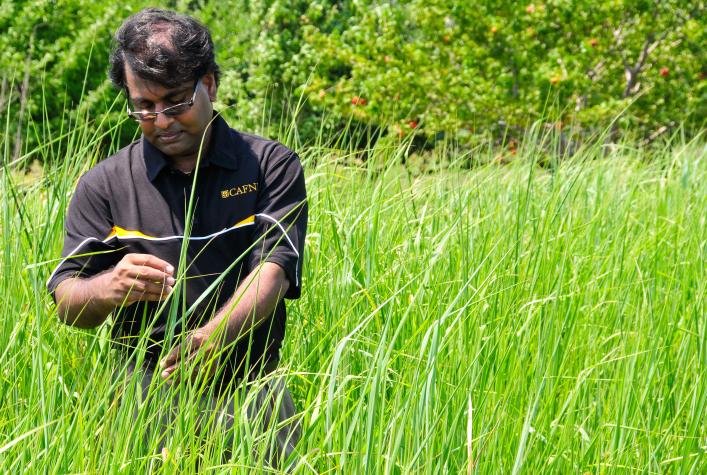MU researchers look at growing second-generation biofuel crops on marginal land.
Writer
Curt WohleberNEW FRANKLIN, Mo. –It takes nature millions of years to turn organic matter into fuel. Technology can do the same thing in hours or even minutes using plants. But so far we still depend on fossil fuels to keep our cars—not to mention our entire civilization—running.
Ethanol from corn helps fuel millions of cars on American roads, as either an additive to ordinary gasoline or the primary ingredient in E85, but corn ethanol isn’t likely to substitute for petroleum in a big way. Among other things, raising corn for fuel uses farmland that could be used to grow food.
That’s where “second-generation” biofuels come in. These fuels can be made from nonfood plants grown on marginal land, including flood plains, where growing corn and other row crops is often unprofitable, according to Shibu Jose, director of the Center for Agroforestry at the University of Missouri and H.E. Garrett Endowed Professor at the MU College of Agriculture, Food and Natural Resources.
But creating a vibrant biofuel industry is a “chicken-or-the-egg” problem, Jose says. Farmers don’t want to invest in these biofuel crops until they know there will be buyers willing to pay a good price for them. “And industrial players like refineries and producers of advanced liquid fuels would like to see sustainable production of biomass crops before they set up shop, which would take millions of dollars of investment.”
Collaborating for energy independence
The Center for Agroforestry is collaborating with the U.S. Department of Energy and other partners to work out how to make advanced biofuels a viable and sustainable business. One of the partners, the University of Florida, is investigating the technology to process biomass into advanced biofuels, including biogasoline, biodiesel and even plant-based butanol to power jet aircraft.
Here in Missouri, the Center for Agroforestry is teaming up with the Show Me Energy Cooperative, a farmer-owned cooperative in Centerview, Mo., that processes biomass from its more than 600 members’ farms for energy and other purposes.
At the MU Horticulture and Agroforestry Research Center in New Franklin, Mo., researchers are testing four species of biofuel crops. To simulate conditions of the flood-prone fields along the Missouri and Mississippi rivers, the crops are grown in huge trenches that will be flooded. This is one of the many trials in which biofuel crops will be studied, Jose said.
The fields include 15 different varieties—cultivars or clones—of each of the four candidate crops: willow, switchgrass, cottonwood and high-biomass sorghum. The researchers will compare how well they grow in different types of soil and under different amounts and duration of flood stress.
The results will reveal which varieties are likely to perform best in the floodplains. This knowledge will guide breeding programs to create new, improved varieties of biomass crops.
Once you grow these crops, you need to take them somewhere to make them into marketable products. But raw biomass can contain up to 50 percent water. With that much dead weight, transporting biomass could easily burn more fuel than would be created if conversion facilities are too far away. That would be bad for both the environment and the bottom line.
That’s where the Show Me Energy Cooperative comes in. Facilities like the co-op’s plant in Centerview convert biomass, which is low in energy density, into energy-dense products, including compact pellets that can be sold to power plants to generate electricity or to homeowners as a heating fuel.
The Centerview plant is an example of what’s called an advanced rural biorefinery, or ARBR, Jose said.
“This is a repeatable, replicable model that can be used anywhere in the U.S.,” he said. “Farmers come together, form co-ops, grow biomass and convert that biomass into either pellets or any number of products that can be derived from that biomass, including liquid transportation fuels.”
Economic rewards and environmental benefits
Establishing ARBRs along the river corridors offers another advantage: Products could be shipped long distances on barges instead of trucks or trains.
“Barge traffic can be highly cost-effective,” Jose said. “A 15-barge tow can replace 1,000 trucks on the highway.”
A side benefit of a network of regional ARBRs is job creation and economic activity, he adds.
In addition to providing new sources of renewable energy, growing biomass crops offers other environmental benefits, often referred to as “ecosystem services.”
For example, most of the candidate crops are perennials, which means you can plant them once and harvest every year for 10 or 15 years. This reduces the need to disturb the soil and apply fertilizers and herbicides, so these crops put much less sediment and chemical runoff into rivers and streams compared to crops like corn and soybeans. These plants also act as natural filters, trapping and breaking down chemicals in runoff from adjacent row-crop fields. Planting these in river floodplains means they’re in an ideal location to intercept that runoff. The plants also provide valuable wildlife habitat.
As with fossil fuels, burning biofuels puts carbon dioxide into the air. However, that carbon dioxide was already in circulation until captured by the crops as they grew. Fossil fuels, on the other hand, add carbon that had been in the ground for millions of years.
Supply and demand
The supply of petroleum is finite—we’re using it much faster than nature is producing it—and unpredictable political and economic conditions mean that buyers can’t count on access to fossil fuels in amounts they need at prices they can afford.
That's why the U.S. Navy, aviation firms and others in the business of moving people, cargo and equipment over long distances are intent securing reliable alternatives to fossil fuels. Federal mandates call for increased use of biofuels, particularly advanced biofuels.
After tests at the New Franklin research farm identify the most promising biomass crops, researchers will work with farmers and industry partners on large-scale field trials.
An era of commonplace advanced biofuels is still at least a few years away, but the seeds have been planted.
